Hao Pan
NeuVAS: Neural Implicit Surfaces for Variational Shape Modeling
Jun 16, 2025Abstract:Neural implicit shape representation has drawn significant attention in recent years due to its smoothness, differentiability, and topological flexibility. However, directly modeling the shape of a neural implicit surface, especially as the zero-level set of a neural signed distance function (SDF), with sparse geometric control is still a challenging task. Sparse input shape control typically includes 3D curve networks or, more generally, 3D curve sketches, which are unstructured and cannot be connected to form a curve network, and therefore more difficult to deal with. While 3D curve networks or curve sketches provide intuitive shape control, their sparsity and varied topology pose challenges in generating high-quality surfaces to meet such curve constraints. In this paper, we propose NeuVAS, a variational approach to shape modeling using neural implicit surfaces constrained under sparse input shape control, including unstructured 3D curve sketches as well as connected 3D curve networks. Specifically, we introduce a smoothness term based on a functional of surface curvatures to minimize shape variation of the zero-level set surface of a neural SDF. We also develop a new technique to faithfully model G0 sharp feature curves as specified in the input curve sketches. Comprehensive comparisons with the state-of-the-art methods demonstrate the significant advantages of our method.
EBS-CFL: Efficient and Byzantine-robust Secure Clustered Federated Learning
Jun 16, 2025Abstract:Despite federated learning (FL)'s potential in collaborative learning, its performance has deteriorated due to the data heterogeneity of distributed users. Recently, clustered federated learning (CFL) has emerged to address this challenge by partitioning users into clusters according to their similarity. However, CFL faces difficulties in training when users are unwilling to share their cluster identities due to privacy concerns. To address these issues, we present an innovative Efficient and Robust Secure Aggregation scheme for CFL, dubbed EBS-CFL. The proposed EBS-CFL supports effectively training CFL while maintaining users' cluster identity confidentially. Moreover, it detects potential poisonous attacks without compromising individual client gradients by discarding negatively correlated gradients and aggregating positively correlated ones using a weighted approach. The server also authenticates correct gradient encoding by clients. EBS-CFL has high efficiency with client-side overhead O(ml + m^2) for communication and O(m^2l) for computation, where m is the number of cluster identities, and l is the gradient size. When m = 1, EBS-CFL's computational efficiency of client is at least O(log n) times better than comparison schemes, where n is the number of clients.In addition, we validate the scheme through extensive experiments. Finally, we theoretically prove the scheme's security.
* Accepted by AAAI 25
LTM3D: Bridging Token Spaces for Conditional 3D Generation with Auto-Regressive Diffusion Framework
May 30, 2025Abstract:We present LTM3D, a Latent Token space Modeling framework for conditional 3D shape generation that integrates the strengths of diffusion and auto-regressive (AR) models. While diffusion-based methods effectively model continuous latent spaces and AR models excel at capturing inter-token dependencies, combining these paradigms for 3D shape generation remains a challenge. To address this, LTM3D features a Conditional Distribution Modeling backbone, leveraging a masked autoencoder and a diffusion model to enhance token dependency learning. Additionally, we introduce Prefix Learning, which aligns condition tokens with shape latent tokens during generation, improving flexibility across modalities. We further propose a Latent Token Reconstruction module with Reconstruction-Guided Sampling to reduce uncertainty and enhance structural fidelity in generated shapes. Our approach operates in token space, enabling support for multiple 3D representations, including signed distance fields, point clouds, meshes, and 3D Gaussian Splatting. Extensive experiments on image- and text-conditioned shape generation tasks demonstrate that LTM3D outperforms existing methods in prompt fidelity and structural accuracy while offering a generalizable framework for multi-modal, multi-representation 3D generation.
Wideband RF Radiance Field Modeling Using Frequency-embedded 3D Gaussian Splatting
May 27, 2025Abstract:This paper presents an innovative frequency-embedded 3D Gaussian splatting (3DGS) algorithm for wideband radio-frequency (RF) radiance field modeling, offering an advancement over the existing works limited to single-frequency modeling. Grounded in fundamental physics, we uncover the complex relationship between EM wave propagation behaviors and RF frequencies. Inspired by this, we design an EM feature network with attenuation and radiance modules to learn the complex relationships between RF frequencies and the key properties of each 3D Gaussian, specifically the attenuation factor and RF signal intensity. By training the frequency-embedded 3DGS model, we can efficiently reconstruct RF radiance fields at arbitrary unknown frequencies within a given 3D environment. Finally, we propose a large-scale power angular spectrum (PAS) dataset containing 50000 samples ranging from 1 to 100 GHz in 6 indoor environments, and conduct extensive experiments to verify the effectiveness of our method. Our approach achieves an average Structural Similarity Index Measure (SSIM) up to 0.72, and a significant improvement up to 17.8% compared to the current state-of-the-art (SOTA) methods trained on individual test frequencies. Additionally, our method achieves an SSIM of 0.70 without prior training on these frequencies, which represents only a 2.8% performance drop compared to models trained with full PAS data. This demonstrates our model's capability to estimate PAS at unknown frequencies. For related code and datasets, please refer to https://github.com/sim-2-real/Wideband3DGS.
MMGen: Unified Multi-modal Image Generation and Understanding in One Go
Mar 26, 2025Abstract:A unified diffusion framework for multi-modal generation and understanding has the transformative potential to achieve seamless and controllable image diffusion and other cross-modal tasks. In this paper, we introduce MMGen, a unified framework that integrates multiple generative tasks into a single diffusion model. This includes: (1) multi-modal category-conditioned generation, where multi-modal outputs are generated simultaneously through a single inference process, given category information; (2) multi-modal visual understanding, which accurately predicts depth, surface normals, and segmentation maps from RGB images; and (3) multi-modal conditioned generation, which produces corresponding RGB images based on specific modality conditions and other aligned modalities. Our approach develops a novel diffusion transformer that flexibly supports multi-modal output, along with a simple modality-decoupling strategy to unify various tasks. Extensive experiments and applications demonstrate the effectiveness and superiority of MMGen across diverse tasks and conditions, highlighting its potential for applications that require simultaneous generation and understanding.
DiffCSG: Differentiable CSG via Rasterization
Sep 02, 2024Abstract:Differentiable rendering is a key ingredient for inverse rendering and machine learning, as it allows to optimize scene parameters (shape, materials, lighting) to best fit target images. Differentiable rendering requires that each scene parameter relates to pixel values through differentiable operations. While 3D mesh rendering algorithms have been implemented in a differentiable way, these algorithms do not directly extend to Constructive-Solid-Geometry (CSG), a popular parametric representation of shapes, because the underlying boolean operations are typically performed with complex black-box mesh-processing libraries. We present an algorithm, DiffCSG, to render CSG models in a differentiable manner. Our algorithm builds upon CSG rasterization, which displays the result of boolean operations between primitives without explicitly computing the resulting mesh and, as such, bypasses black-box mesh processing. We describe how to implement CSG rasterization within a differentiable rendering pipeline, taking special care to apply antialiasing along primitive intersections to obtain gradients in such critical areas. Our algorithm is simple and fast, can be easily incorporated into modern machine learning setups, and enables a range of applications for computer-aided design, including direct and image-based editing of CSG primitives. Code and data: https://yyyyyhc.github.io/DiffCSG/.
PS-CAD: Local Geometry Guidance via Prompting and Selection for CAD Reconstruction
May 24, 2024Abstract:Reverse engineering CAD models from raw geometry is a classic but challenging research problem. In particular, reconstructing the CAD modeling sequence from point clouds provides great interpretability and convenience for editing. To improve upon this problem, we introduce geometric guidance into the reconstruction network. Our proposed model, PS-CAD, reconstructs the CAD modeling sequence one step at a time. At each step, we provide two forms of geometric guidance. First, we provide the geometry of surfaces where the current reconstruction differs from the complete model as a point cloud. This helps the framework to focus on regions that still need work. Second, we use geometric analysis to extract a set of planar prompts, that correspond to candidate surfaces where a CAD extrusion step could be started. Our framework has three major components. Geometric guidance computation extracts the two types of geometric guidance. Single-step reconstruction computes a single candidate CAD modeling step for each provided prompt. Single-step selection selects among the candidate CAD modeling steps. The process continues until the reconstruction is completed. Our quantitative results show a significant improvement across all metrics. For example, on the dataset DeepCAD, PS-CAD improves upon the best published SOTA method by reducing the geometry errors (CD and HD) by 10%, and the structural error (ECD metric) by about 15%.
ComboStoc: Combinatorial Stochasticity for Diffusion Generative Models
May 22, 2024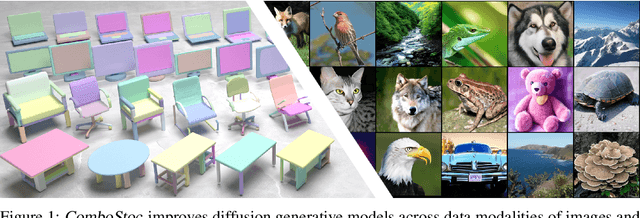
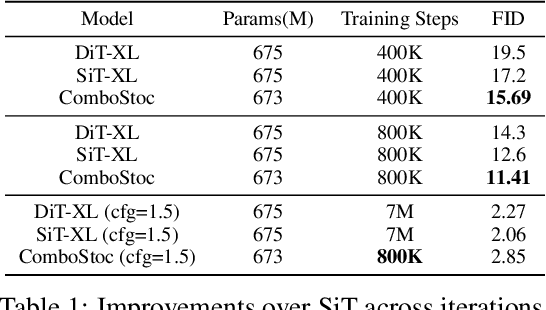


Abstract:In this paper, we study an under-explored but important factor of diffusion generative models, i.e., the combinatorial complexity. Data samples are generally high-dimensional, and for various structured generation tasks, there are additional attributes which are combined to associate with data samples. We show that the space spanned by the combination of dimensions and attributes is insufficiently sampled by existing training scheme of diffusion generative models, causing degraded test time performance. We present a simple fix to this problem by constructing stochastic processes that fully exploit the combinatorial structures, hence the name ComboStoc. Using this simple strategy, we show that network training is significantly accelerated across diverse data modalities, including images and 3D structured shapes. Moreover, ComboStoc enables a new way of test time generation which uses insynchronized time steps for different dimensions and attributes, thus allowing for varying degrees of control over them.
MVD$^2$: Efficient Multiview 3D Reconstruction for Multiview Diffusion
Feb 22, 2024



Abstract:As a promising 3D generation technique, multiview diffusion (MVD) has received a lot of attention due to its advantages in terms of generalizability, quality, and efficiency. By finetuning pretrained large image diffusion models with 3D data, the MVD methods first generate multiple views of a 3D object based on an image or text prompt and then reconstruct 3D shapes with multiview 3D reconstruction. However, the sparse views and inconsistent details in the generated images make 3D reconstruction challenging. We present MVD$^2$, an efficient 3D reconstruction method for multiview diffusion (MVD) images. MVD$^2$ aggregates image features into a 3D feature volume by projection and convolution and then decodes volumetric features into a 3D mesh. We train MVD$^2$ with 3D shape collections and MVD images prompted by rendered views of 3D shapes. To address the discrepancy between the generated multiview images and ground-truth views of the 3D shapes, we design a simple-yet-efficient view-dependent training scheme. MVD$^2$ improves the 3D generation quality of MVD and is fast and robust to various MVD methods. After training, it can efficiently decode 3D meshes from multiview images within one second. We train MVD$^2$ with Zero-123++ and ObjectVerse-LVIS 3D dataset and demonstrate its superior performance in generating 3D models from multiview images generated by different MVD methods, using both synthetic and real images as prompts.
Mastering the Game of Guandan with Deep Reinforcement Learning and Behavior Regulating
Feb 21, 2024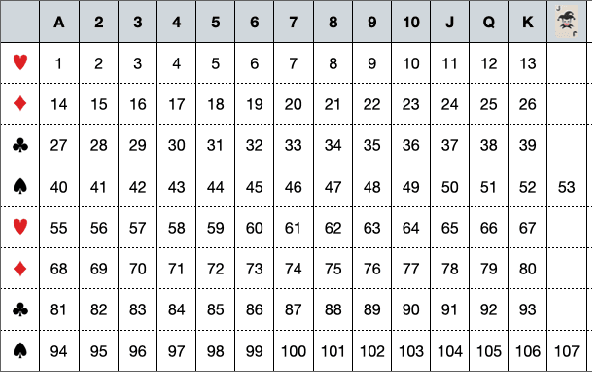
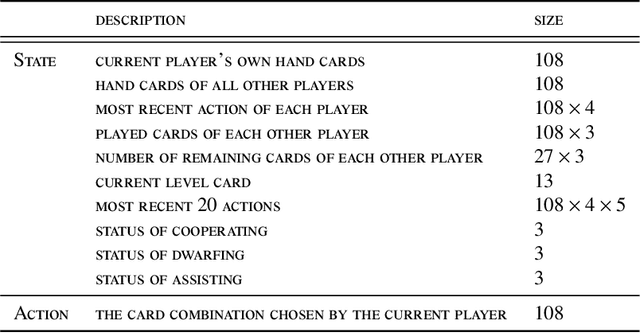
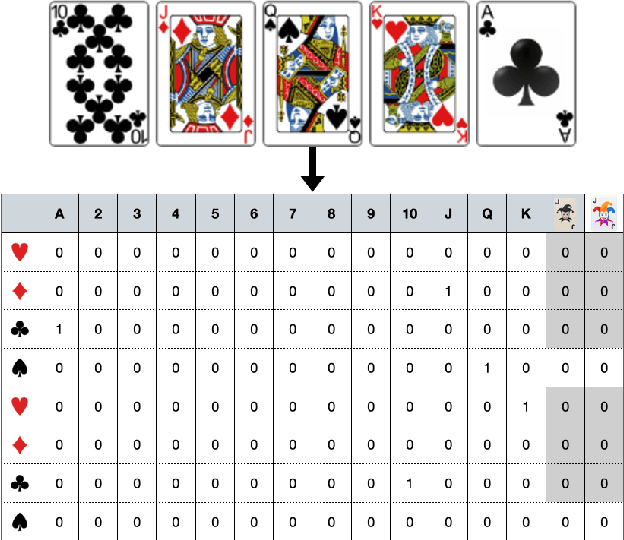
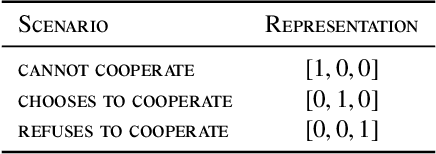
Abstract:Games are a simplified model of reality and often serve as a favored platform for Artificial Intelligence (AI) research. Much of the research is concerned with game-playing agents and their decision making processes. The game of Guandan (literally, "throwing eggs") is a challenging game where even professional human players struggle to make the right decision at times. In this paper we propose a framework named GuanZero for AI agents to master this game using Monte-Carlo methods and deep neural networks. The main contribution of this paper is about regulating agents' behavior through a carefully designed neural network encoding scheme. We then demonstrate the effectiveness of the proposed framework by comparing it with state-of-the-art approaches.
 Add to Chrome
Add to Chrome Add to Firefox
Add to Firefox Add to Edge
Add to Edge